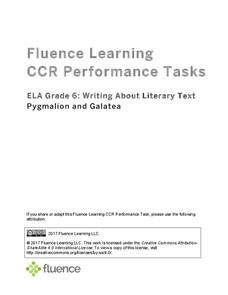Fluence Learning
Writing About Literary Text: Pygmalion and Galatea
Is it crazy to fall in love with your own work, or is that the purest love of all? Compare two renditions of the classic Greek myth Pygmalion and Galatea with a literary analysis exercise. After students compare the similarities and...
Houghton Mifflin Harcourt
Alexander Graham Bell
Study the features of nonfiction text with a set of comprehension and analysis materials. Readers learn about Alexander Graham Bell with questions about the text, writing prompts, and proofreading activities.
New York State Education Department
Comprehensive English Examination: January 2014
What better way to prepare learners for academic success than to administer practice tests? With the Comprehensive Examination in English, scholars read informational and literary texts and answer listening and reading comprehension...
Lesson Plansos
Guided Reading Activities with Pizzazz
Get the most out of your guided reading lessons with this collection of literacy materials. Offering a system for using color-coded tags to mark pages while reading books, as well as an assortment of comprehension and grammar worksheets,...
Maryland Department of Education
Our Children Can Soar
Amazing efforts of African American leaders are celebrated in a lesson on civil participation. The engaging resource focuses on primary and secondary sources to analyze the impact of African American leaders such as Ella Fitzgerald....
Curated OER
The Tell-Tale Heart
Bring Edgar Allan Poe's spooky story to life! After reading the short story "The Tell-Tale Heart," middle and high schoolers identify the theme, character traits, irony, and other story concepts. During pre-reading, they take notes,...
Nazareth College
Creative Writing
Students discuss creative writing—what makes something creative writing? Each learner starts writing a story and after 15 minutes, they pass their story to another who adds to it. After another 15 minutes of writing, the story is passed...
Curated OER
I Know Why the Caged Bird Sings
Students examine the use of hyperbole in Maya Angelou's I Know Why the Caged Bird Sings. In this literary analysis lesson, students read and discuss chapter 31 from the story. Students write the definition for hyperbole and locate...
Curated OER
Conflict
Learners outline the action in their narrative writing assignments by brainstorming about conflict. In this conflict analysis lesson, students define conflict and discuss the different types of conflict. Learners brainstorm about a...
Curated OER
Pre- and Post-Reading Plan
Students are introduced to pre- and post-reading strategies. Individually, they read excerpts of a story while making predictions about what they believe is going to happen next. After reading the selection, they answer comprehension...
Curated OER
Fiction vs. Nonfiction
Students explore fiction and nonfiction writing. They identify the elements of fiction in a short story and identify the criteria necessary in a nonfiction piece. Students distinguish the author's purpose in an expository text,...
Curated OER
A Feat of Daring with Lewis and Clark Jeopardy
Sixth graders discover the exploration of the United States by participating in a class activity. In this U.S. History lesson, 6th graders research the Lewis and Clark expedition and participate in a game of Jeopardy based on the two...
Curated OER
Where Did My Lunch Come From? A U.S. Regional Tour
Students explore the five regions of the United States. In this social studies lesson, students discuss the regions and the states located in that region. Students discuss the types of food produced in each region and analyze a school...














